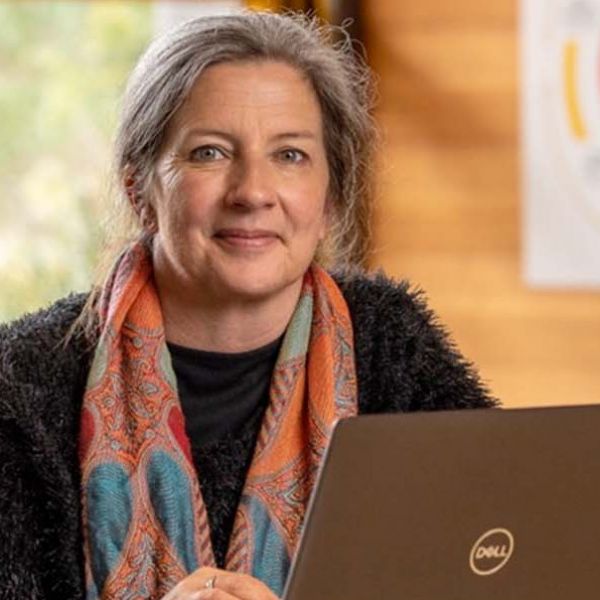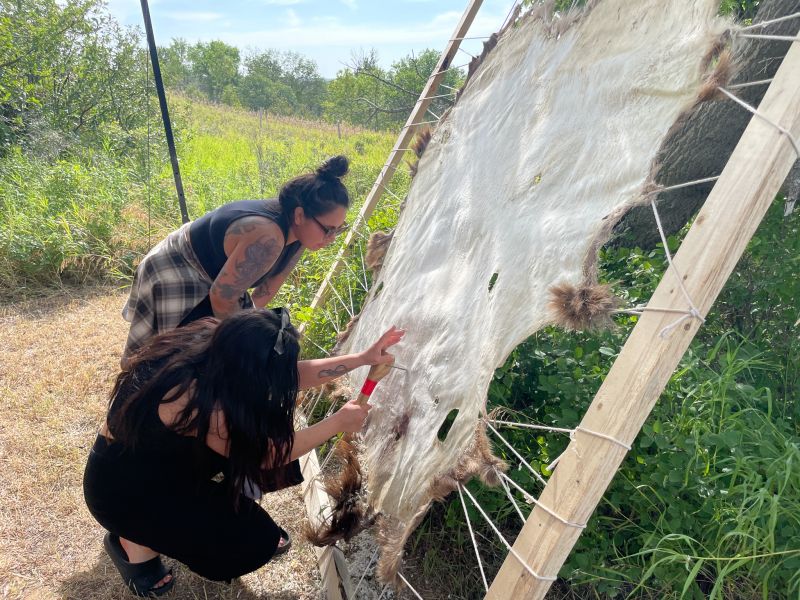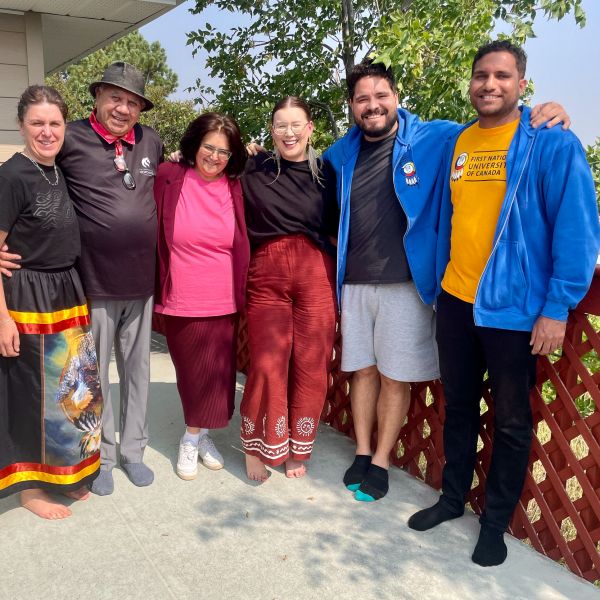PhD student, Jodan Perry, said it was such a memorable experience, one he will never forget and shares his story with us.
A light tipi stood tall, piercing through the night sky.
It wasn’t just a structure - it symbolised the unity and purpose of this gathering, a space where diverse voices would converge to share.
Torches, held by Indigenous people from across the world, met at its apex, each beam carrying the stories and experiences of those who came here.
As winds swirled and bugs swarmed, participants stood steadfast, their presence forming an ethereal beacon that lit up the moment.
On the first night, tears flowed freely during the Full Moon Ceremony, led by Métis Elder Shelly Belhumeur.
What began with the practices of smudging and sharing ceremonial tobacco evolved into a safe Talking Circle, where personal reflections were met with love and understanding.
It was an intense moment, as people who had only met that morning found themselves deeply connected.
“Companionship, respect, community - these words matter. Building relationships, keeping them strong, and passing on culture,” said Elder Shelley, when asked what she hoped participants would take from the week.
“This is how we will pass on knowledge: by returning to the land and listening to each other. Whether old, young, Elder or student - everyone has something to share.”
Coming together
These are just two of the many stories from the inaugural International Traditional Indigenous Knowledges Institute (ITIKI) gathering, hosted by the First Nations University of Canada on the beautiful lands between Saskatoon and the Whitecap Dakota Nation.
ITIKI builds upon the work that began in 1998 with Indigenous Elders and educators at the 'Voices of the Drum' Summer Institute, continuing a legacy of fostering reciprocal exchanges and preserving traditional Indigenous knowledge.
Over five packed days, nearly 30 graduate students and guests from Australia, New Zealand, Canada, and the United States came together with Elders and Knowledge Keepers from the University. The land-based gathering focused on traditional Indigenous ways of being, knowing, and doing, offering a deep exchange of culture and story.
"It was a magnificent event that exceeded all expectations," said Professor Bob Morgan, beaming as we spoke in Saskatoon after the conclusion of the gathering.
"We had this dream that something like this was possible. Sitting in the circle this morning, reflecting on the one-word evaluation was incredible. All the students shared their amazing academic journeys. It's truly inspiring to see what some of our people are achieving."
Standing still
Newcastle’s delegation included Professor Morgan, Professor Kathleen Butler, and UoN PhD students James Ballangary, Shea Calvin, Shellie Smith, and myself.
On the first morning, initial worries about being far from home were quickly put to rest. Elder Roland Duquette reminded us to be fully present, away from technology.
“The Creator will take care of our families,” he said. “Let’s just be here.”
As the week went on, listening became central to everything we did. Not once do I recall anyone interrupting another - it was a space where every voice was heard fully.
Stepping away from packed calendars, emails, and deadlines to embrace the fluidity of time was grounding.
“When Elder Willie spoke, he opened the space in such a profound way,” James Ballangary reflected.
“We were there for three hours, but it felt like only 45 minutes. We were completely present.”
Gifts of gratitude
Relationships and sharing were central themes throughout the week. Shellie Smith sat quietly on the floor weaving while we gathered in the common room for indoor activities.
It wasn’t until the final day I learned she had been creating her art pieces - turtles and baskets - while listening to the Elders, knowing she would gift them as a gesture of respect and gratitude.
“Participating in those deep Yarning Circles, listening to the Elders and reflecting on their teachings, has been life-changing,” Shellie shared.
“I’m so grateful to have learned from them, and I hope to pass those teachings on. The friendships I’ve made here are going to last a lifetime.”
Other Elders and Knowledge Keepers that contributed included Maria Campbell (Cree/Métis), Felix Lockhart (Dene), Joseph Naytowhow (Cree), and Cheryl L’Hirondelle (Métis/Cree). Sharing space with them was also a special experience for Professor Kath Butler.
“I spent a lot of time with Shelle and Cheryl throughout the week. Hearing their love of culture, their enthusiasm, creativity, and above all, their wisdom and kindness - it’s been life-changing,” she said.
“What amazes me most in these events is understanding both the similarities and differences between the various Indigenous peoples.”
Related articles

Big dreams built through remote community partnership
The unlikely pairing of outback Menindee and seaside Newcastle have successfully bridged the distance
Read more

Community connection
For some people, the knowledge of who they are and where they come from is clouded in mystery. A new workshop, led by The Wollotuka Institute, aims to clear the air.
Read more

Protecting Indigenous knowledges
During his research to unlock the archives, Dr Hodgetts found that the keys had been long-kept from cultural knowledge-holders.
Read more
Common threads
James and I spent many hours with Masters student and Cree language speaker, Darian Agecoutay, endlessly impressed by his fluency and deep historical knowledge of his people.
Darian comes from Cowessess First Nation, where, in 2021, the discovery of at least 751 unmarked graves at the former Marieval Indian Residential School reverberated around the world. I had come across this story while working for National Indigenous Television in Australia that same year. To now be sitting with him and hearing firsthand the weight of that history made the moment more moving.
We also spoke about our pasts, growing up, and many other topics, finding strength in the common ground we shared. In between, we swapped slang, nicknamed him ‘Dazza,’ and discovered ‘Neon Moon’ is as popular with the mob there as it is back home.
We also learned that baloney sandwiches with ketchup-flavoured crisps are a favourite treat.
Land-based learning
Other activities included learning to construct a tipi and a sweat, which brought people even closer together. We also visited Batoche, a historic site significant for its role in the 1885 North-West Rebellion, which today stands as a symbol of Métis culture and heritage.
At Wanuskewin, we learned about the Northern Plains Indigenous peoples, the Bison Jump, and took part in a bush food walk.
We participated in hide tanning, pipe ceremonies, and experimental art forms like the light tipi and Buffalo Transformation. Through it all, storytelling remained the common thread.
“I remember Elder Maria Campbell saying on one of the first days, ‘places are just layers of stories,’ and that resonated throughout our time here,” said Shea Calvin.
“All of the Elders shared their teachings and wisdom through story, and that was one of the most incredible takeaways.”

University of Waikato Student Stevie-Rae Ofanoa participating in the hide tanning process

Artist Cheryl L’Hirondelle led the experimental activity to create a tipi with smoke and light

Large white tipi in a grassy plain.

The team went to Wanuskewin to learn local history and experience story through art
Bison, berries and beyond
FNUniv President Jacqueline Ottmann was a constant warm presence throughout the gathering. Vice Chiefs of the Federation of Sovereign Indigenous Nations, Aly Bear and Craig McCallum, spoke powerfully while midweek, outgoing Mayor of Saskatoon Charlie Clark visited, and his passion for improving the lives of First Nations was evident in his emotional words, leaving a lasting impression.
In addition to these experiences, participants were encouraged to submit their reflections to a special issue of Thrivance: Journal of Indigenous Ways of Being, Knowing, and Doing, dedicated to this inaugural gathering.
Culinary highlights came from Chef Kirk Ermine, who prepared traditional foods like Bison, Elk, Chokecherries, Fry Bread, and generous use of the Saskatoon Berry. What I found particularly memorable were the traditional songs Kirk played each morning as he cooked a wall away from where I slept. The beat of those drumlines waking me became a source of comfort - something I still carry.
The gathering marked the beginning of something special, for Professor Morgan, as the University of Newcastle prepares to host the event in 2025.
“I’m very sad it’s over,” he said.
“Some people I knew before, but the new friends - like the ladies from New Zealand and the students from the University of British Columbia - made it such a wonderful experience."
“Next year, we have the responsibility of hosting it. We’ll design a program just as memorable and continue this journey.”
We left with many stories from this special place, and soon, we’ll welcome our new friends to create their own.
Next year’s location for the International Traditional Indigenous Knowledges Institute Gathering will be hosted by the University of Newcastle, and the Wollotuka Indigenous Institute is thrilled to plan for 2025.



























